The 2023 Nissan Ariya and 2023 Volkswagen ID.4 electric crossovers point their brands into the future. Both of these battery electric vehicles aim to be the volume model in each brand’s growing electric vehicle family. Though they each have two battery pack options, single or dual-motor choices, a range of about 255 miles on average, an ovoid shape that opens up all kinds of interior space, and seat five passengers, they approach the market differently.
The Nissan Ariya takes an evolutionary leap from the Nissan Leaf hatchback that launched late in 2010 as the first mass-produced electric car. Despite delays in launching the 2023 Ariya and arriving later than many other electric crossovers, the Ariya shines as Nissan’s nicest vehicle, regardless of powertrain. The interior design and finish qualify as nicer than most Infiniti vehicles, as well. This can make it expensive, however, with a top price exceeding $60,000.
Volkswagen takes a friendlier price stance and a more budget-minded approach. VW’s had more time to play with configurations since the ID.4 launched in 2021, resulting in a base price below $40,000. The value extends to its extensive driver-assist tech and comfort and convenience features, but its touchscreen interface and capacitive climate sliders test a user’s patience.
Which one is right for you? It depends on what matters most, which is why we break it down here.
Nissan Ariya vs. VW ID.4 pricing and trims
Both models have two battery pack sizes
A single motor and front-wheel drive are standard
Dual-motor all-wheel drive is optional
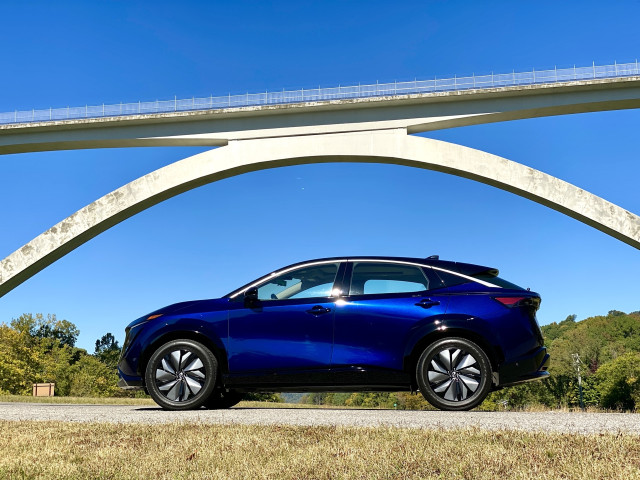
2023 Nissan Ariya
How much is a Nissan Ariya? Which Nissan Ariya should I buy?
The base Engage trim with the smaller 63-kwh battery pack costs about $45,000
The $52,000 Evolve+ bundles the best features
Dual-motor all-wheel drive costs about $4,000 more
The Engage trim starts the Ariya bidding at about $45,000, including a $1,295 destination fee (all listed vehicle prices include destination). Of the five trims, it’s the only model with the smaller 63-kwh battery pack, but Nissan loads it up with nice features such as twin 12.3-inch screens with wireless Apple CarPlay, a head-up display, and heated front and rear seats covered in synthetic leather. Every Ariya comes with a basic 3-year/36,000-mile basic warranty, though it includes scheduled service, and the battery is covered for 8 years or 100,000 miles.
The $49,000 Venture+ trim represents the starting point for the 87-kwh battery pack, but it’s not as well equipped as the Engage. We’d step up to the Evolve+ for $51,500. It has the same content as the Engage but adds a panoramic sunroof, a surround-view camera system, a power center console, and a wireless smartphone charger. We’d make it an all-wheel-drive e-4orce model—despite the goofy name—for the extra boost in power for $4,000 more.
The $61,500 Platinum e-4orce tops the range and exceeds our consideration. Cooled front seats, a 10-speaker Bose sound system, and nappa leather aren’t enough to keep us from looking at a similarly priced luxury electric crossover such as the Genesis GV60 or the bestselling Tesla Model Y.
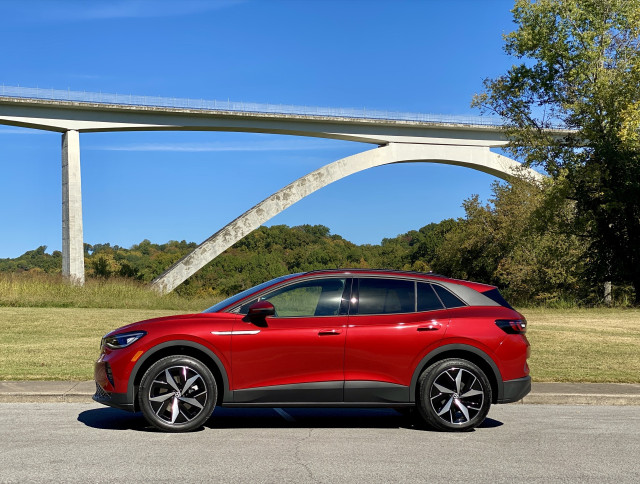
2023 Volkswagen ID.4
How much is a Volkswagen ID.4? Which VW ID.4 should I buy?
The base Standard trim with the smaller 62-kwh battery pack costs about $40,000
The $45,000 ID.Pro packs the best value
Dual-motor all-wheel drive costs $3,800 more
With production moved from Germany to Tennessee in 2023, the VW ID.4 qualifies for the full $7,500 federal tax credit, depending on your tax liability. Without it, the ID.4 with the smaller 62-kwh battery pack costs just over $40,000. That model, the ID.4 Standard, comes with good driver-assist tech as well as heated front seats, heated side mirrors, ambient lighting, keyless start, and a smartphone wireless charger.
The best value is the ID.4 Pro with the 82-kwh pack that has the same equipment for $5,000 more. AWD adds $3,800 with the larger pack; it’s not offered on the standard pack.
At the top of the lineup is the Pro S Plus AWD for $56,500. It builds off the 20-inch wheels, heated steering wheel, synthetic leather upholstery, and fixed glass roof of the ID.4 Pro S model, and adds a black roof, heated rear seats, a surround-view camera system, and three-zone climate control.
Overall, the ID.4 is a better value than the Ariya, even without the EV tax credit. A better warranty sweetens the pot even more: Every ID.4 has a 4-year/50,000-mile new car warranty, an 8-year/100,000-mile battery warranty, and complimentary scheduled maintenance for 2 years or 20,000 miles.
Advantage: VW ID.4.
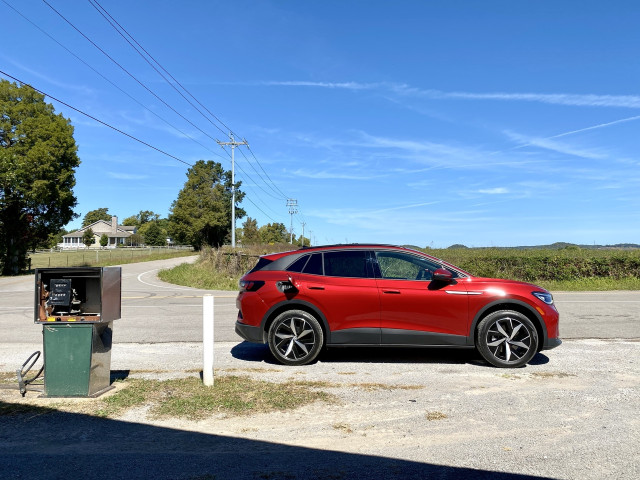
2023 Volkswagen ID.4
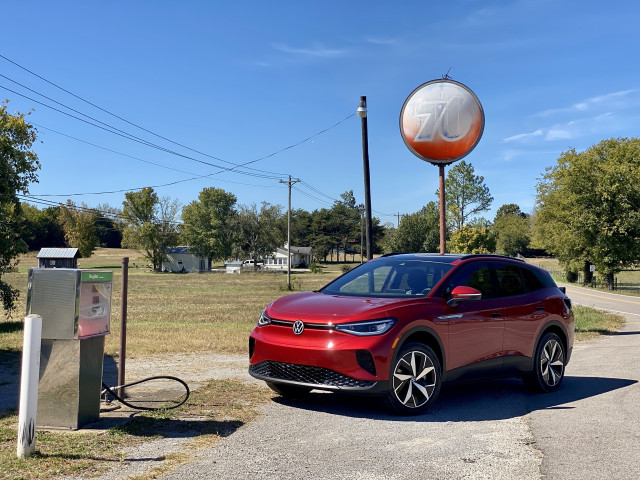
2023 Volkswagen ID.4
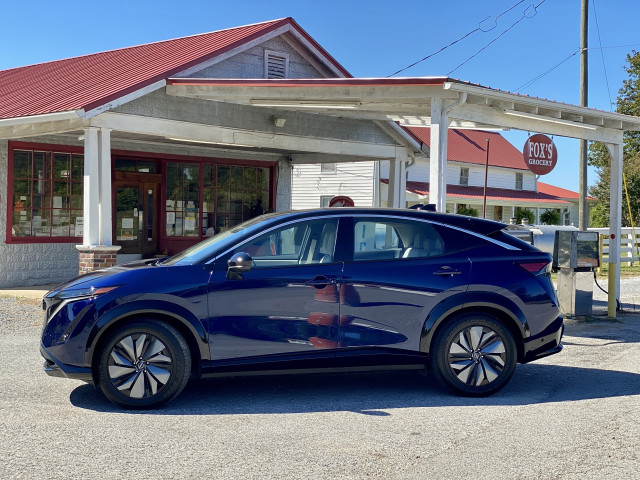
2023 Nissan Ariya

2023 Nissan Ariya
Nissan Ariya vs. Volkswagen ID.4 range, efficiency, and charging
Nissan Ariya range: Base Engage trim 216 miles or 205 miles with AWD; Venture+ trim, 304 miles; other trims 289 miles or 272 miles with AWD
Volkswagen ID.4 Standard and S 209 miles; Pro, Pro S, Pro S Plus, 275 miles or 255 miles with AWD
Both models average about 3.0 miles per kwh
The Ariya has a heat pump; ID.4s sold in the U.S. do not have a heat pump
Is the VW ID.4 good on energy?
Yes. Single-motor models with both the 62-kwh and 82-kwh battery packs go 3.2 miles per kwh, which is above average for the electric compact crossover class. All-wheel-drive versions with two motors rate at 2.9 miles per kwh.
The smaller pack can be DC fast-charged to 80% at a rate of up to 140 kw in about 40 minutes. The larger pack charges at up to 170 kw in 30 minutes. That’s essentially a free fill-up since VW includes 30-minute fast-charge sessions on the Electrify America network for the first three years of ownership. On a 240-volt home charger, the ID.4’s 11-kw onboard charger enables a full charge in about 6.5 hours.
Is the Nissan Ariya good on energy?
Yes, but it comes up a bit shy of the ID.4 The 63-kwh, single-motor model gets up to 3.1 miles per kwh, whereas dual-motor models with the larger pack rate just under 2.8 miles per kwh.
The Ariya DC fast-charges at up to 130 kw to replenish the battery from 20% to 80% in 40 minutes. Nissan provides a 7.2-kw onboard charger to charge at home on a Level 2 240-volt circuit at 30 amps: The small battery charges to full in about 10 hours, and the larger battery takes 14 hours.
It’s worth noting that the Ariya uses a heat pump that helps warm the cabin or precondition the battery to boost efficiency. ID.4 models sold in the U.S. do not have a heat pump.
Advantage: VW ID.4, though the Ariya has slightly more range.
VW ID.4 vs Nissan Ariya performance
Both models start with single-motor front-wheel drive
Optional dual-motor all-wheel drive costs $4,000 on the Ariya, $3,800 on ID.4
Nissan Ariya is quicker
Neither model has one-pedal braking
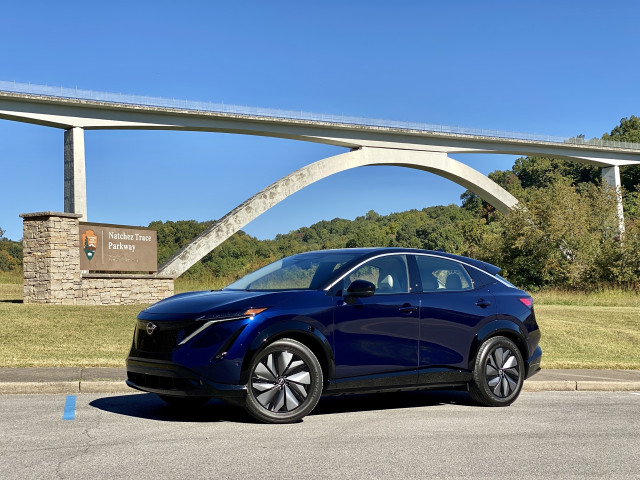
2023 Nissan Ariya
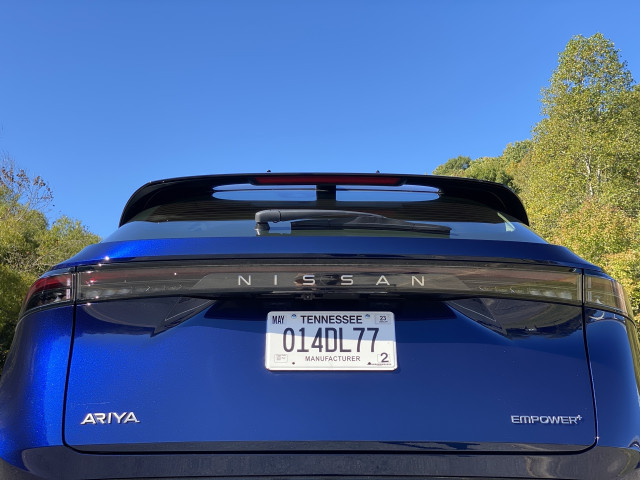
2023 Nissan Ariya
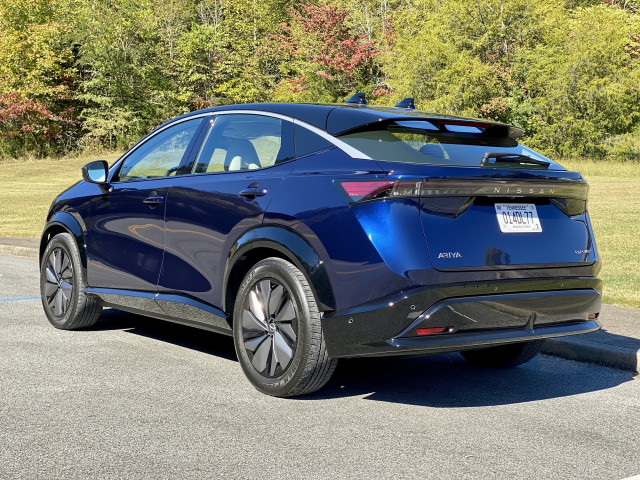
2023 Nissan Ariya
How fast is the Nissan Ariya?
The Ariya’s performance won’t accelerate blood pressures with a 0-60 mph time of 7.2 seconds for single-motor versions. The soothing cabin might calm blood pressures enough to wean passengers off their diuretics, however. Front-wheel-drive versions make 214 hp with the 63-kwh pack or 238 hp with the 87-kwh pack, though the 221 lb-ft of torque is the same.
The e-4orce AWD models pump blood to the pace of 335 hp and 413 lb-ft with the smaller pack or 389 hp and 442 lb-ft with the larger pack, and a 0-60 mph time of 4.8 seconds.
The front struts and multilink rear suspension feel altogether springy, though the extra weight of the AWD models results in more balance and better handling. The base Engage model weighs 4,300 pounds, while the top Platinum+ model with the large pack tips the scale at more than 5,000 pounds. The soft steering would rather not respond to assertive inputs, and that’s in character with the Ariya. It’s made for comfort, and it’s made well. There’s some wind noise from the side mirrors at highway speeds, but overall the cabin is exceptionally quiet.
Does the Ariya have regenerative braking?
The Ariya comes with two regen brake settings that help replenish the battery when coasting or braking. Similar to the Nissan Leaf, an “E-step” mode recaptures energy more assertively but doesn’t bring the Ariya down to a stop. The B setting in the gear selector seems grabbier. There’s also no auto hold function that enables you to take your foot off the brake at longer stops.
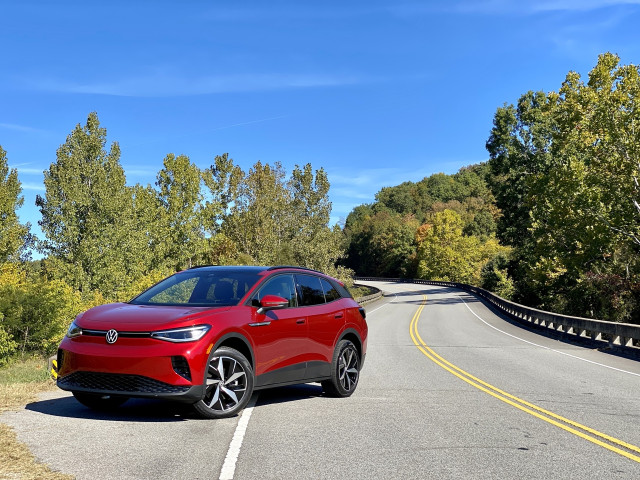
2023 Volkswagen ID.4

2023 Volkswagen ID.4
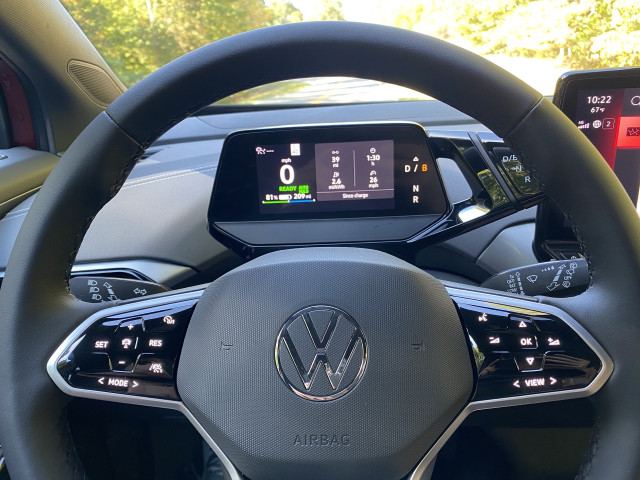
2023 Volkswagen ID.4
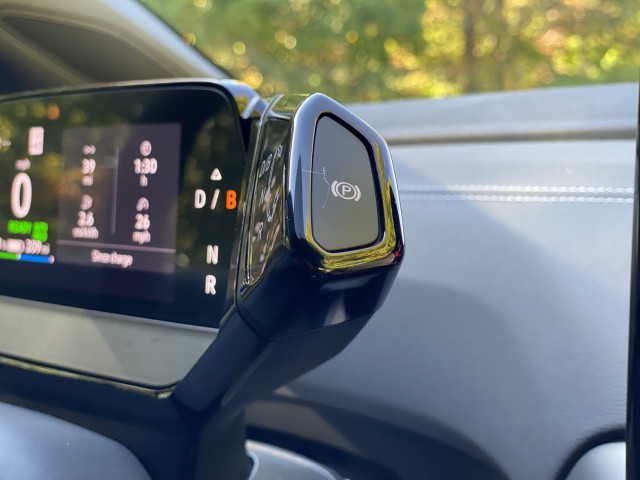
2023 Volkswagen ID.4
How fast is the VW ID.4?
The Volkswagen ID.4 Pro dual-motor model feels performance oriented by comparison to the Ariya, despite being slower. Buttoned-down handling, good steering, and a planted ride all make it all more connected to the road.
Single-motor models make 201 hp and 229 lb-ft and go from 0-60 mph in the mid-seven second range. The all-wheel-drive model has a system output of 295 hp and 339 lb-ft of torque and a 0-60 mph time of 5.4 seconds. With linear power delivery, the ID.4 doesn’t surge off the line like more powerful electric vehicles, yet there’s plenty of surge to beat a merge.
The ID.4’s front struts and multilink rear suspension are tuned a bit firmer than the Nissan Ariya. The AWD model weighs about 150 pounds less than the Ariya, and like its rival, there is wind and tire noise on the 20-inch wheels. Eco, Comfort, Sport, and Custom modes add slight variability to the accelerator response and steering feel, but the charm of the ID.4 resides in its direct steering that’s more of the exception in the electric crossover class.
Does the ID.4 have regenerative braking?
It does, but it does not have one-pedal braking. The ID.4 has a single B mode regenerative brake setting with a noticeable difference from coasting like in a gas car. To activate the auto hold function in B mode, press firmly on the brake and an icon will appear so you can take your foot off the brake at stoplights.
Advantage: Nissan Ariya, though the ID.4 handles better.

2023 Volkswagen ID.4
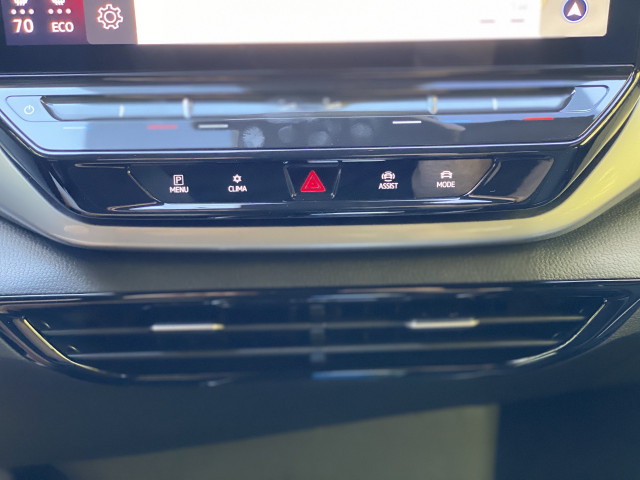
2023 Volkswagen ID.4
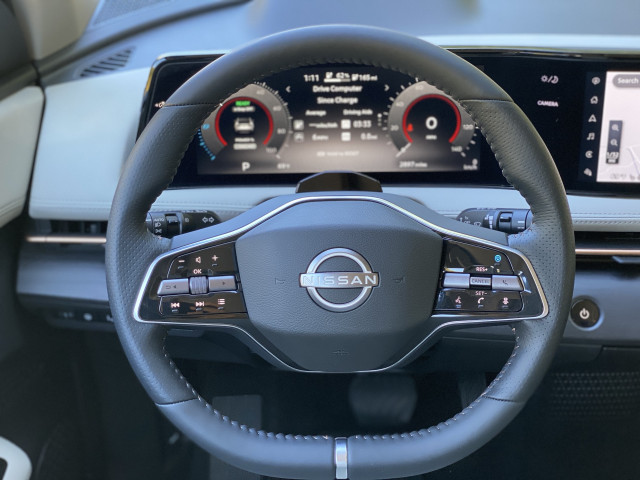
2023 Nissan Ariya
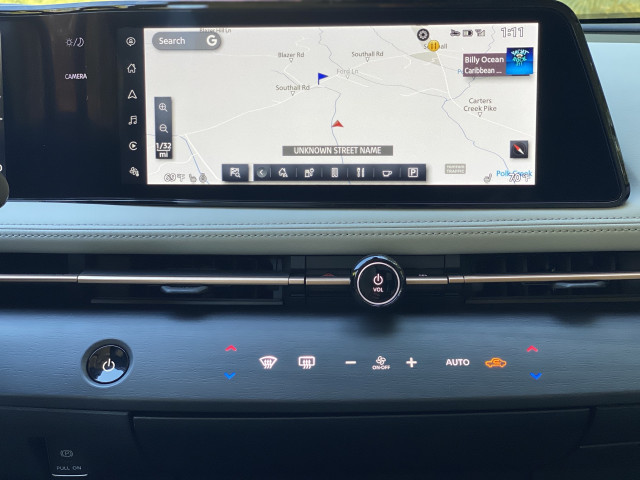
2023 Nissan Ariya
Nissan Ariya vs VW ID.4 technology
Nissan Ariya sports twin 12.3-inch screens
VW ID.4 has a 12.0-inch touchscreen
Nissan’s system is much more user friendly.
How is the infotainment system in the Nissan Ariya?
Good. Every Ariya serves as a beacon for the rest of the Nissan brand. A 12.3-inch digital instrument cluster bends into a sharp 12.3-inch infotainment screen on every model. Wireless Apple CarPlay comes standard but Android Auto requires a cord. A vertical menu bar has small but simple icons with customizable widgets. Nissan doesn’t rely on the screen for every function. A volume dial sits below it in the vent panel, and haptic climate buttons blend into the wood dash. A wifi hotspot and at least four USB ports front and rear also come standard.
How is the infotainment system in the VW ID.4?
Befuddling. Volkswagen reinvented the interface here but didn’t improve it. The layers of information don’t cascade logically. Tuning an XM radio station, for example, requires at least five clicks if you don’t have the channel preselected. Alternatively, you can press the voice command button and say “tune XM radio to channel 36.” The ID.4 has capacitive touch surfaces on the climate and steering wheel controls that are too sensitive yet they’re less precise than buttons and dials. The interface showcases its tech potential but doesn’t seem to factor in its underlying functionality while driving. It could use a reboot.
Advantage: Nissan Ariya.
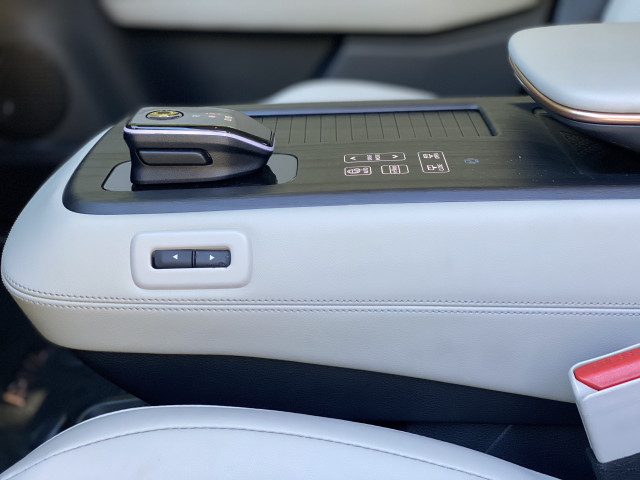
2023 Nissan Ariya
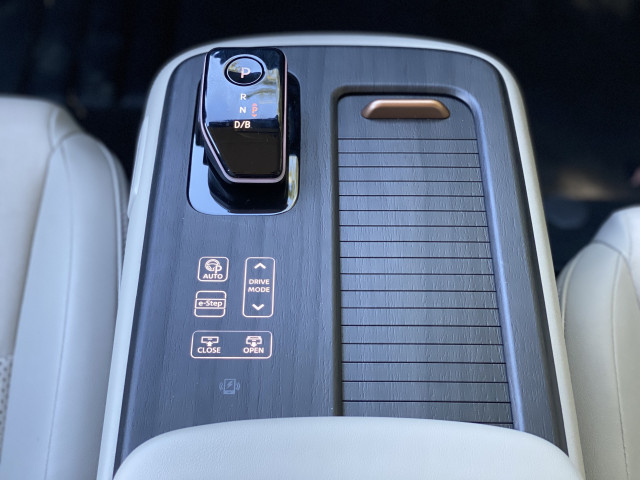
2023 Nissan Ariya
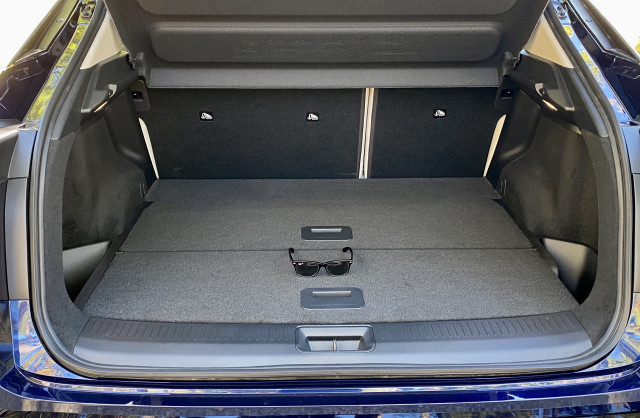
2023 Nissan Ariya
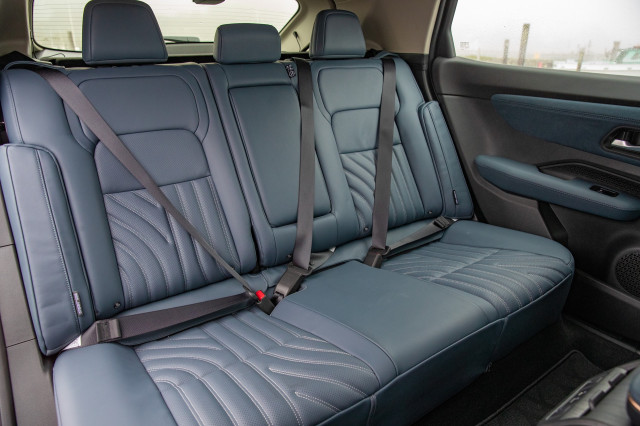
2023 Nissan Ariya e-4orce
Nissan Ariya vs VW ID.4 cargo and seating
VW ID.4 cargo room extends from 30.3 to 64.2 cubic feet with the 60/40-split rear seats folded down
Ariya cargo room measures at 22.8 or 59.7 cubic feet
37.6 inches of rear legroom in the ID.4
37.0 inches of rear legroom in the Ariya
Which electric crossover is bigger?
Both electric vehicles optimize the space afforded them by a flat open floor, but the Volkswagen ID.4 is roomier inside while the Nissan Ariya is nicer. This one’s all about tradeoffs.
Both models have available fixed glass roofs, but Nissan’s is separated by a crossmember that allows it to open. Both have 60/40-split folding rear seats, but only the ID.4 has a pass-through for longer items. Both have tiered cargo floors with clever storage recesses under the floor, but neither has a frunk.
The cost-cutting seems most evident in the ID.4’s wireless smartphone holder. A clip holds the phone in place in the angled slot. The Ariya’s plush seats and foamy side bolsters indicate it’s built for comfort, and an available power sliding center console that can move six inches is a thoughtful touch. Both vehicles are built solidly in a way Tesla has yet to master, but the wood trim and sexy cross-stitching on the Ariya make it a nicer place to be, even if the ID.4 is roomier.
Advantage: ID.4 for space, Nissan Ariya for style.
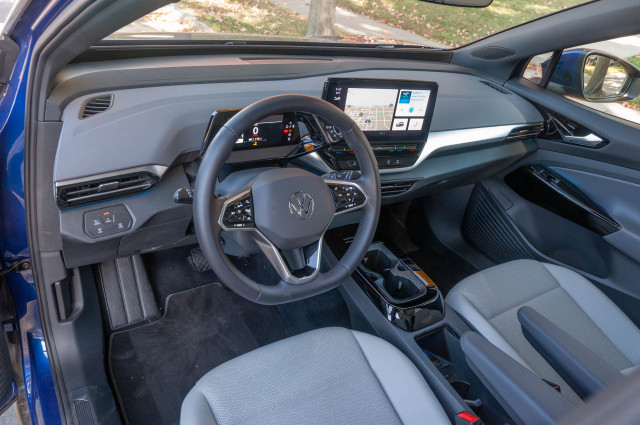
2021 Volkswagen ID.4
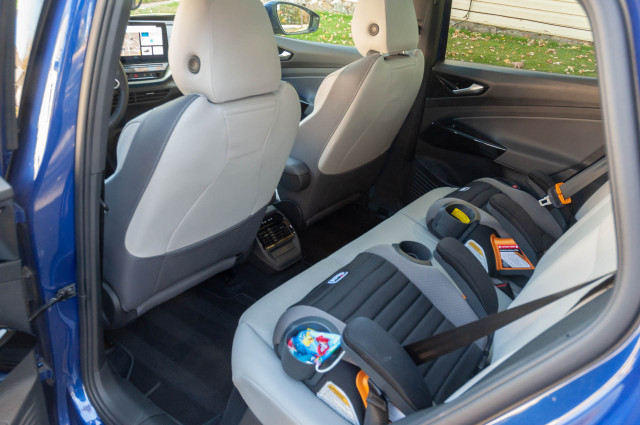
2021 Volkswagen ID.4
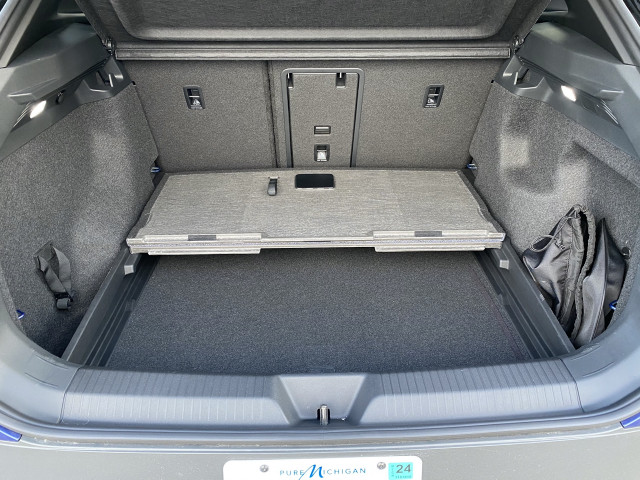
2021 Volkswagen ID.4 1st Edition
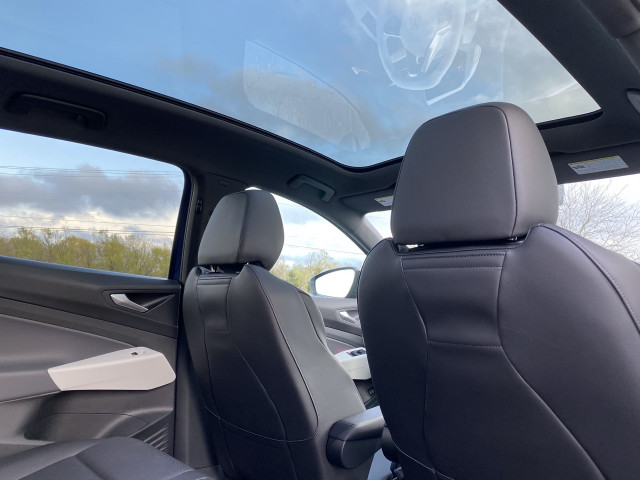
2021 Volkswagen ID.4 1st Edition
VW ID.4 vs Nissan Ariya safety
ID.4 nets five stars from the NHTSA and an IIHS Top Safety Pick+
The Ariya has not yet been crash tested by either agency
Both have great outward vision
The Volkswagen ID.4 has been around longer, giving the NHTSA and the IIHS time to test it and earn highest honors. Neither safety agency has tested the Nissan Ariya. Both models come standard with automatic emergency braking with pedestrian detection, blind-spot monitors, parking sensors, active lane control, LED headlights with automatic high beams, and adaptive cruise control with driver-initiated lane changes.
Nissan’s available ProPilot Assist 2.0 provides hands-free driving on more than 200,000 miles of mapped divided highways in the U.S. and Canada, courtesy of TomTom. The HD mapping is updated automatically when you start the car. It’s not as sophisticated as GM’s Super Cruise, but it’s better than most other limited hands-free driving systems.
Advantage: Inconclusive.

2023 Nissan Ariya
Which is better: Nissan Ariya vs. VW ID.4?
They match up pretty closely on the spec sheet, from the battery pack sizes to the interior dimensions. The Volkswagen ID.4 benefits from being a value and having a roomier interior, earning a TCC Rating of 7.8 out of 10. But it can’t match the elevated status of the Nissan Ariya. Its beautiful interior and thoughtful controls, as well as its longer range not only make it the nicest Nissan on the market, it’s also one of the nicer electric crossovers in the $50,000 range. That charm helped it earn a TCC Rating of 8.6 out of 10. (Read more about how we rate cars.) Yet it can’t match the ID.4’s overall value, which could be the key selling point.













